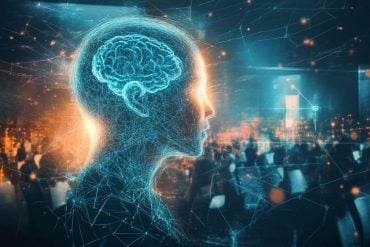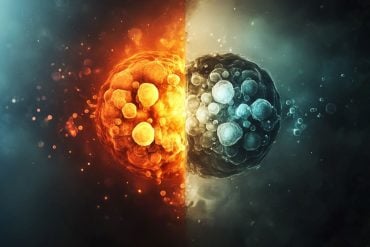Summary: The number of times a woman gives birth has an effect on physical aging. Women who give birth less than, or more than, three or four times age faster after menopause.
Source: Penn State
Having children doesn’t just make you feel like you’ve aged overnight — a new study led by Penn State researchers found that the number of times a person gives birth may also affect the body’s physical aging process.
The researchers examined several different measures that represent how a person’s body is aging and found that people who had few births — or many — seemed to have aged quicker than those who had given birth three or four times. However, these effects were found only after a person had gone through menopause.
“Our findings suggest that pregnancy and birth may contribute to the changing and dysregulation of several different physiological systems that may affect aging once a person is post-menopause,” said Talia Shirazi, a doctoral candidate in biological anthropology at Penn State. “This is consistent with the metabolic, immunological, and endocrinological changes that occur in the body during pregnancy and lactation, as well as the various disease risks that are associated with pregnancy and reproductive investment more generally.”
According to the researchers, pregnancy and breastfeeding use a large amount of the body’s energy and can affect many of its systems, including immune function, metabolism, and blood pressure, among others. Additionally, people who have given birth are more likely to die from diabetes, kidney disease, and hypertension, among other conditions, than those who have not.
The researchers were curious about how the body balances these “costs of reproduction” and whether it affects how the body ages.
“We think there’s something going on, some sort of trade-off, between aging and reproduction,” Shirazi said. “This makes sense from an evolutionary biology point of view, because if you’re spending energy in pregnancy and breastfeeding, you probably don’t have as much energy to allocate towards things like physiological maintenance and defense.”
For the study, the researchers used data on 4418 participants from the Centers for Disease Control and Prevention’s National Health and Nutrition Examination Survey. Data included information about reproductive health including the number of live births and whether they had gone through menopause or not.
The researchers measured biological aging in several ways based on nine biomarkers designed to assess metabolic health, kidney and liver function, anemia and red blood cell disorders, and immune function and inflammation.
“We wanted to look at measures that would help capture the age and functioning of the body’s major organ systems, instead of looking at aging at the cellular level,” said Waylon Hastings, postdoctoral researcher at Penn State. “When we think about pregnancy, we don’t think about changes to individual cells but instead about how the immune system or metabolism changes, for example.”

The researchers found a “U‐shaped relationship” between the number of live births and accelerated biological aging. Those reporting zero or few live births, or reporting many live births, had markers of quicker biological aging than those who reported three or four live births. This was true even when controlling for chronological age, lifestyle, and other health‐related and demographic factors.
Shirazi said that because the data was taken at one point in time, it’s not currently possible to know what caused these associations. But she said one possible explanation for the findings — recently published in Scientific Reports — is the presence, or lack, of ovarian hormones in post-menopausal people.
“Previous research has found that generally, ovarian hormones are protective against some cellular level processes that might accelerate aging,” Shirazi said. “So it’s possible that in pre-menopausal women the effect of hormones are buffering the potential negative effect of pregnancy and reproduction on biological age acceleration. And then perhaps when the hormones are gone, the effects can show themselves.”
Hastings said the study also suggests that additional research can be done to understand the processes that may be involved in the connection between aging and having children, as well as how these processes work over time.
“This transition into menopause, and female reproductive health in general, is very much under researched and not as well understood as it should be at this time,” Hastings said. “So if we can see that there are these changes in aging as a function of reproduction and menopause, and we don’t have a great explanation for why, then that’s a sign we should investigate this more.”
Asher Rosinger, Ann Atherton Hertzler Early Career Professor in Global Health, and Calen Ryan, Northwestern University, also participated in this work.
Funding: The National Science Foundation, National Institute on Aging, and the Natural Sciences and Engineering Research Council of Canada helped support this research.
About this aging research news
Source: Penn State
Contact: Katie Bohn – Penn State
Image: The image is in the public domain
Original Research: Open access.
“Parity predicts biological age acceleration in post-menopausal, but not pre-menopausal, women” by Talia N. Shirazi, Waylon J. Hastings, Asher Y. Rosinger & Calen P. Ryan. Scientific Reports
Abstract
Parity predicts biological age acceleration in post-menopausal, but not pre-menopausal, women
Understanding factors contributing to variation in ‘biological age’ is essential to understanding variation in susceptibility to disease and functional decline. One factor that could accelerate biological aging in women is reproduction. Pregnancy is characterized by extensive, energetically-costly changes across numerous physiological systems. These ‘costs of reproduction’ may accumulate with each pregnancy, accelerating biological aging. Despite evidence for costs of reproduction using molecular and demographic measures, it is unknown whether parity is linked to commonly-used clinical measures of biological aging. We use data collected between 1999 and 2010 from the National Health and Nutrition Examination Survey (n = 4418) to test whether parity (number of live births) predicted four previously-validated composite measures of biological age and system integrity: Levine Method, homeostatic dysregulation, Klemera–Doubal method biological age, and allostatic load. Parity exhibited a U-shaped relationship with accelerated biological aging when controlling for chronological age, lifestyle, health-related, and demographic factors in post-menopausal, but not pre-menopausal, women, with biological age acceleration being lowest among post-menopausal women reporting between three and four live births. Our findings suggest a link between reproductive function and physiological dysregulation, and allude to possible compensatory mechanisms that buffer the effects of reproductive function on physiological dysregulation during a woman’s reproductive lifespan. Future work should continue to investigate links between parity, menopausal status, and biological age using targeted physiological measures and longitudinal studies.






